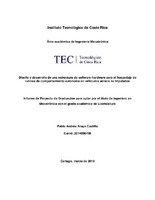| dc.contributor.advisor | Crespo-Mariño, Juan Luis | es |
| dc.contributor.author | Araya-Castillo, Pablo Andrés | |
| dc.date.accessioned | 2019-08-23T23:09:33Z | |
| dc.date.available | 2019-08-23T23:09:33Z | |
| dc.date.issued | 2019 | |
| dc.identifier.uri | https://hdl.handle.net/2238/10735 | |
| dc.description | Informe de proyecto de graduación (Licenciatura en Ingeniería Mecatrónica) Instituto Tecnológico de Costa Rica, Escuela de Ingeniería Mecatrónica, 2018. | es |
| dc.description.abstract | The Integrated Group for Engineering Research (GII) is an R & D group from the University of A Coruña that has a research line of unmanned aerial vehicles (UAV). They have worked on multiple applications with UAVs using the Pixhawk autopilot. The vehicles receive instructions from a remote control while sends flight status information to a ground control station (GCS), a computer to visualize what is happening during the execution of a mission. However, the UAVs were unable to perform tasks that involved autonomous behavior, and the communication with the GCS was not fluid enough to visualize the flight correctly. To solve the problem, a functionally flexible hardware and software structure was implemented in a UAV, which included a mini PC on board in which autonomous and non-autonomous flight routines can be programmed, which give the Pixhawk instructions directly. In addition, a GCS displays the flight status with more fluid communication and the decisions taken by the vehicle. The correct performance of the structure was verified through simulations and validated with an autonomous test flight, in which the UAV decided and executed its own route according to the conditions of the programmed mission. | es |
| dc.description.abstract | El Grupo Integrado de Ingeniería (GII) es un grupo de I+D de la Universidad de La Coruña que posee una línea de investigación de vehículos aéreos no tripulados (UAV, del inglés unmanned aerial vehicle). Han trabajado en múltiples aplicaciones con UAVs usando el autopiloto Pixhawk. Los vehículos reciben instrucciones de un mando remoto a la vez que envían información del estado de vuelo a una computadora de control en tierra (CCT) para visualizar lo que está pasando durante la ejecución de una misión.
Sin embargo, los UAVs eran incapaces de ejecutar tareas que involucraran comportamiento autónomo, además de que la comunicación con la CCT no era suficientemente fluída para visualizar el vuelo correctamente.
Para solucionar el problema se implementó una estructura funcionalmente flexible de hardware y software en un UAV, que incluyó una mini PC a bordo en la cual se pueden programar rutinas de vuelo tanto autónomas como no autónomas, que le dan instrucciones al Pixhawk directamente. Además en una CCT se visualiza el estado de vuelo con una comunicación más fluída y las decisiones que está tomando el vehículo.
Se verificó el correcto funcionamiento de la estructura a través de simulaciones y se validó con un vuelo de prueba autónomo, en el cual el UAV decidió y ejecutó su propia ruta de acuerdo a las condiciones de la misión programada. | es |
| dc.language.iso | spa | es |
| dc.publisher | Instituto Tecnológico de Costa Rica | es |
| dc.rights | acceso abierto | es |
| dc.subject | Plan de vuelo | es |
| dc.subject | Líneas de comunicación | es |
| dc.subject | Investigación | es |
| dc.subject | Vehículos no tripulados | es |
| dc.subject | Software | es |
| dc.subject | Hardware | es |
| dc.subject | Research Subject Categories::TECHNOLOGY::Engineering mechanics | es |
| dc.title | Diseño y desarrollo de una estructura de software-hardware para el hospedaje de rutinas de comportamiento autónomo en vehículos aéreos no tripulados | es |
| dc.type | proyecto fin de carrera | es |


